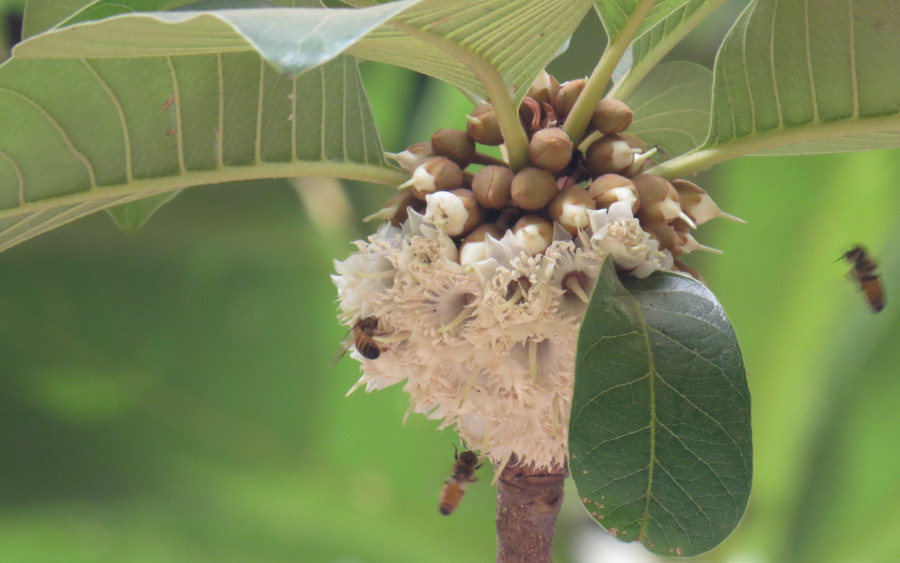Money
With less Chiuri flowering, beekeepers’ income plunges
Honey production has gone down by as much as 60 percent due to much fewer flowers in the chiuri tree and changing flowering timings, say beekeepers.
Pratap Bista & Ramesh Kumar Paudel
Last year Aitaram Chepang of Silinge in Raksirang Rural Municipality Ward No.6, Makwanpur sold honey worth Rs1.5 million harvested from his 200 beehives. This year, he has 25 more beehives, but the production has decreased.
Last year, he could extract honey every 10 days but this year he has been harvesting only every 15 days with very little yield.
“It’ll be difficult to harvest even Rs500,000 worth of honey this year,” said Chepang.
The dramatic decrease in honey production, according to beekeepers from the rural municipality, is because of decline in the number of Chiuri, Indian butter plant (diploknema butyracea), blooms in the forests this year. According to beekeepers, the flowering of Chiuri trees was also delayed by about a month leading to low production of honey.
“Chiuri flowering was delayed this year leading to a decrease in the production of honey. The income source of farmers has also declined drastically this year," said Singh Bahadur Chepang, chairman of ward No. 6 of the rural municipality.
According to Dinesh Chepang, manager of Sana Kishan Cooperatives who buys and sells honey in the Silinge area, honey production has declined by more than 60 percent this year. “All beekeepers are going through the same situation in the Silinge area,” he said.
Chiuri is an important source of honey for commercial beekeepers in Chitwan and Makwanpur districts. Beekeepers move around the district carrying hives as Chiuri flowers bloom at different times in different places.
But this year only a quarter of Chiuri trees bore flowers, say beekeepers.
“In my opinion only 20-25 percent of Chiuri flowers have blossomed this year as compared to the previous years in Chitwan," said Shiva Prasad Sharma Poudel, central president of Federation of Nepal Beekeepers. “That too a month later than previous years,” he said.
Dharam Raj Lama, coordinator of the operational support committee of the bee zone run by the Bharatpur office of the Prime Minister's Agriculture Modernisation Project agrees with Poudel.
“It has been 11 years since local farmers in the two districts took to beekeeping, this is the first time so few Chiuri flowers bloomed,” said Lama.
Beekeepers have had to contend with fewer and delayed blossoms this year and if this continues into the next season of Chiuri blossom then the beekeeping business will be in a crisis.
The blossoming season for Chiuri starts from mid-August to mid-February depending on the variety of the Chiuri plant and the topography.
According to Lama, in Lothar in Chitwan, the Chiuri blossoming period is mid-August; Chiuri begins to bloom in the Shaktikhor, Chitwan and Raksirang areas of Makwanpur after mid-November. “Chiuri that used to bloom in mid-November started flowering only in mid-January this year," he said.
Although bees also graze on mustard, buckwheat and rudilo (pogostemon benghalensis), Chiuri trees in the forests make up more than 80 percent of the honey bees' food diet, says Lama.
Beekeepers can only extract two lots of honey from bees feeding on mustard and buckwheat plants whereas they can extract four lots of honey from Chiuri bees. “We can extract only one lot from bees that graze on rudilo,” said Lama.
According to Suresh Basnet, co-coordinator of the operational support committee of the bee zone, farmers spray pesticides on mustard and buckwheat fields which affects bees and the honey they produce. “But there is no such problem for bees in chiuri forests.”
“In the one-year period between mid-April, 2019 to mid-April 2020, the cooperative had sold more than 20 tonnes of honey. But it looks like it won’t be possible to produce even five tonnes of honey by mid-April this year,” Dinesh Chepang told the Post.
The average honey production in the last two years was 35 kg per hive but it will not even be 20 kg this year, according to the Federation of Nepal Beekeepers.
The Sana Kishan Cooperatives in Silinge has sold only two tonnes of honey after buying it from farmers so far this fiscal year.
“The cooperative had bought and sold 12 tonnes of honey in between mid-April to mid-December in 2019,” said Lama.
Dharmaraj Shrestha, a honey producer, sells honey worth Rs 40 million a year not only in the country but also abroad.
“Last year, I sent 20 tonnes of Chiuri honey to Japan," he said. “My clients are willing to buy Chiuri honey produced in the high hills since there is no use of pesticide.
However, honey farmers in the area are worried because Chiuri trees in the forests of Makwanpur and Chitwan are old and there are no concrete plans to plant new Chiuri trees.
“This year, the weather pattern changed and that might have caused less flowering," said Madhav Poudel, Agriculture Officer at the Prime Minister's Agriculture Modernisation Project Bharatpur Office.
Whatever the reason for the lowering is, it is a subject of study according to Poudel of Federation of Nepal Beekeepers.
“We hope proper research and study will be conducted to ascertain the cause and effect in the decline in honey production and fewer blooms of Chiuri in the forests of Chitwan and Makwanpur,” said Poudel.
This article has been updated for clarity.




 9.12°C Kathmandu
9.12°C Kathmandu
1.jpg)















